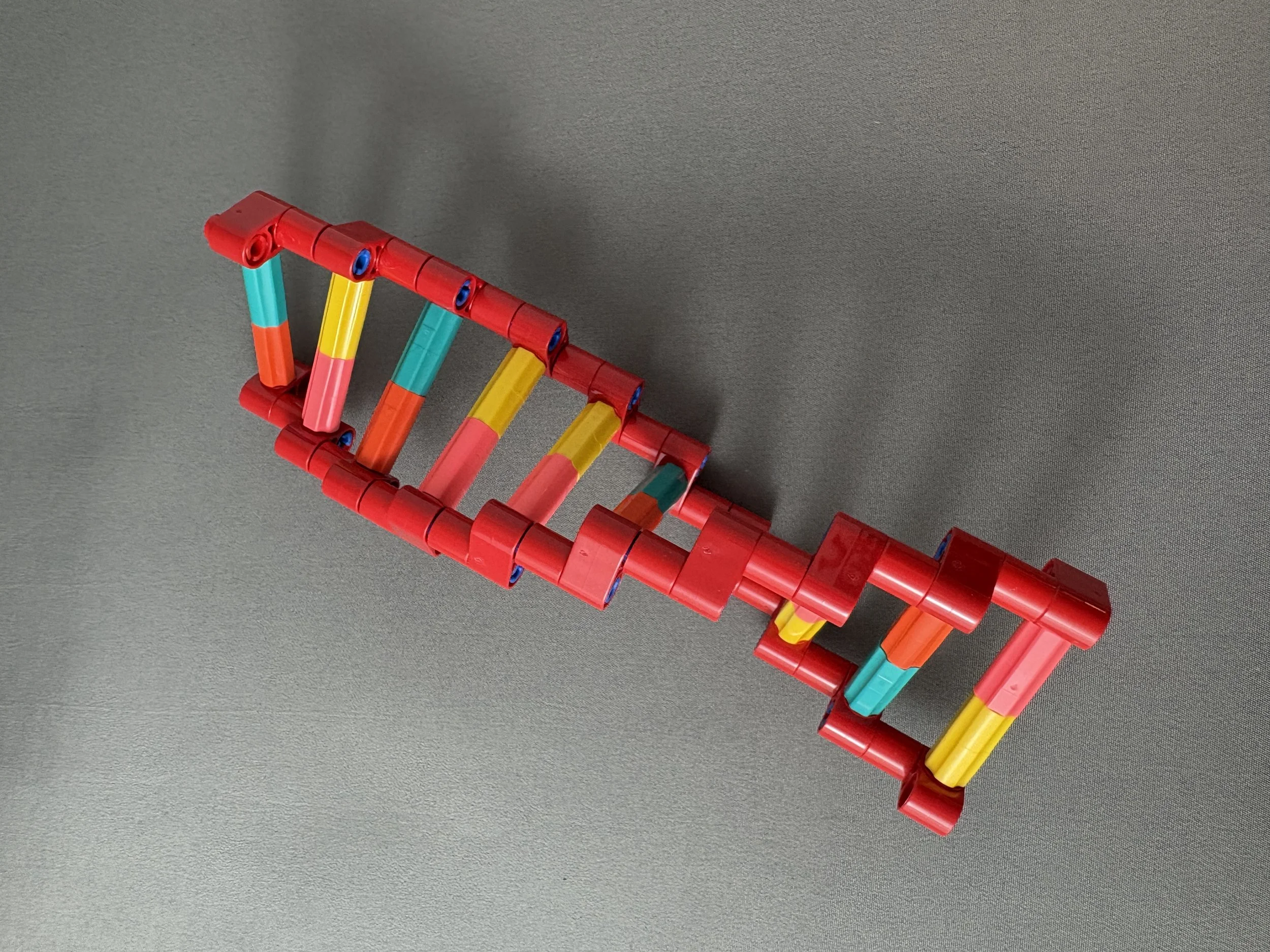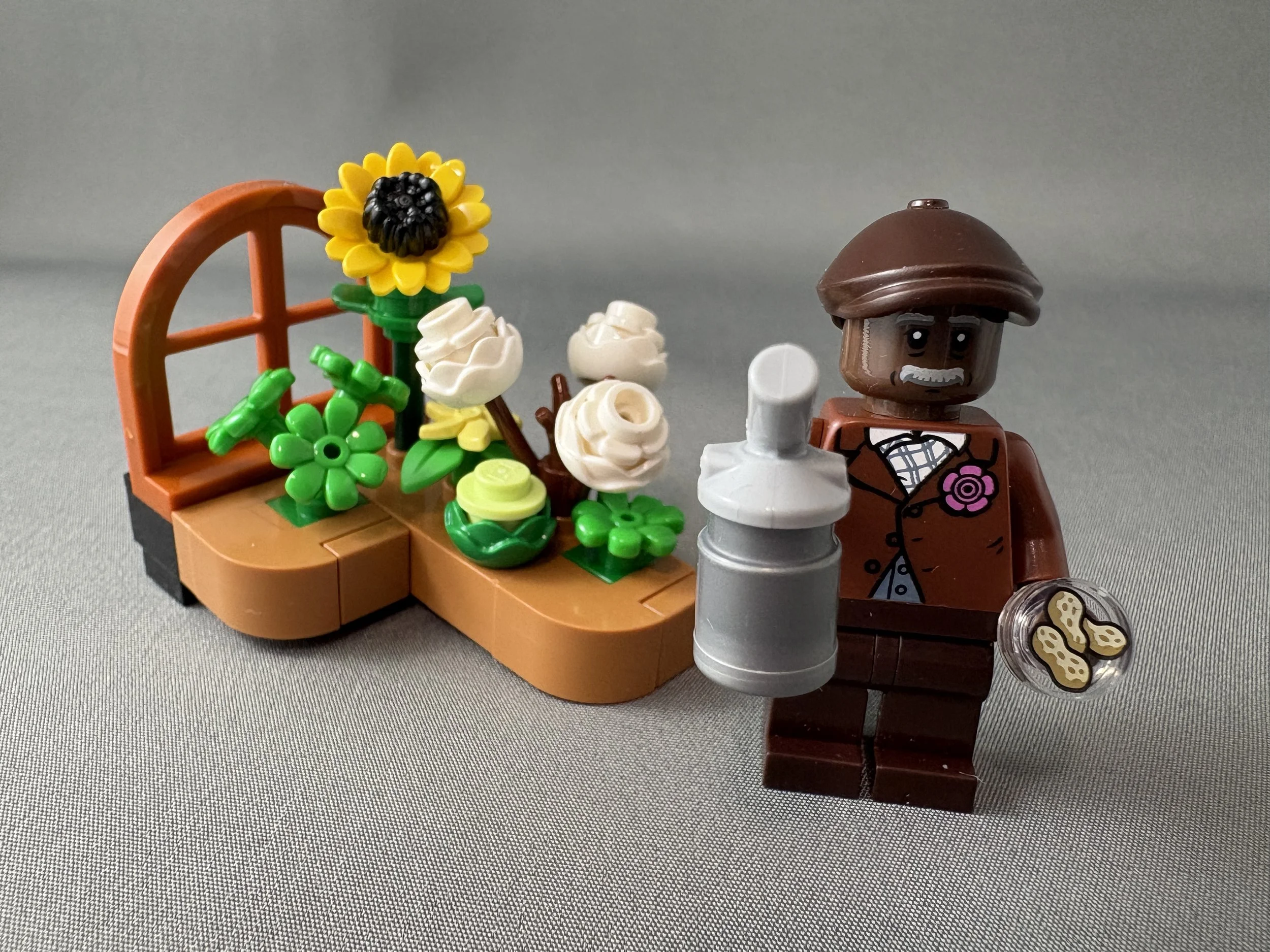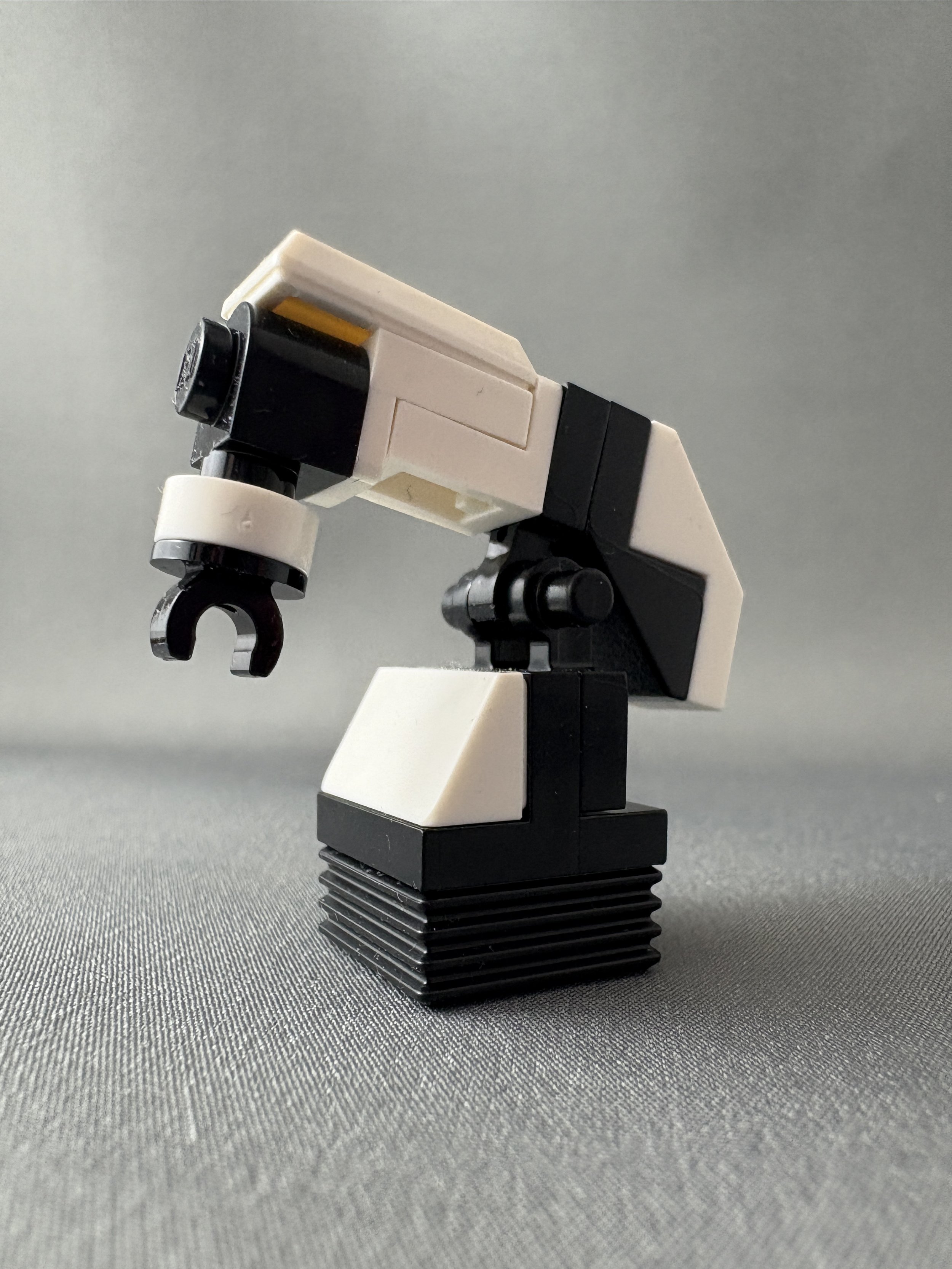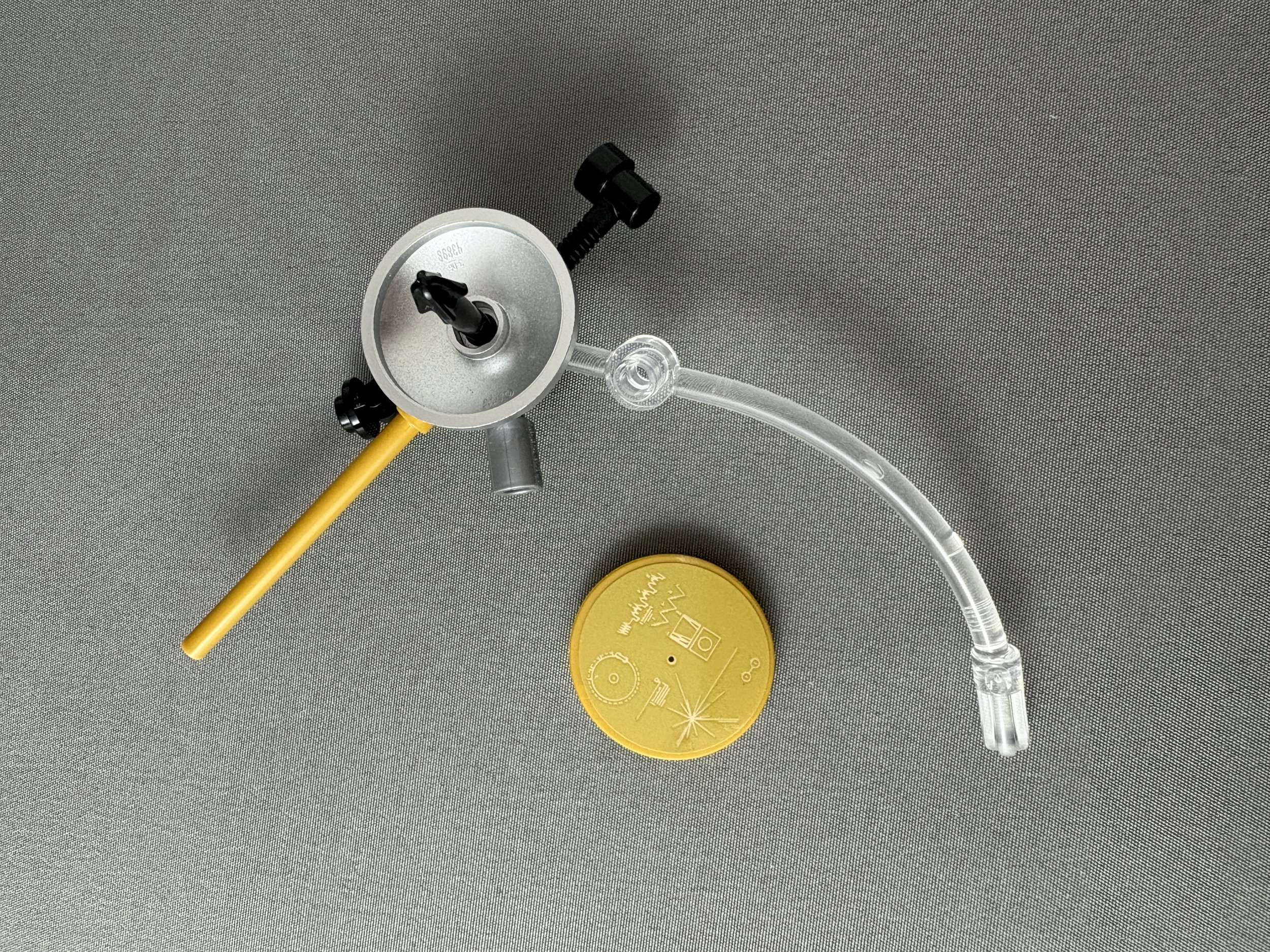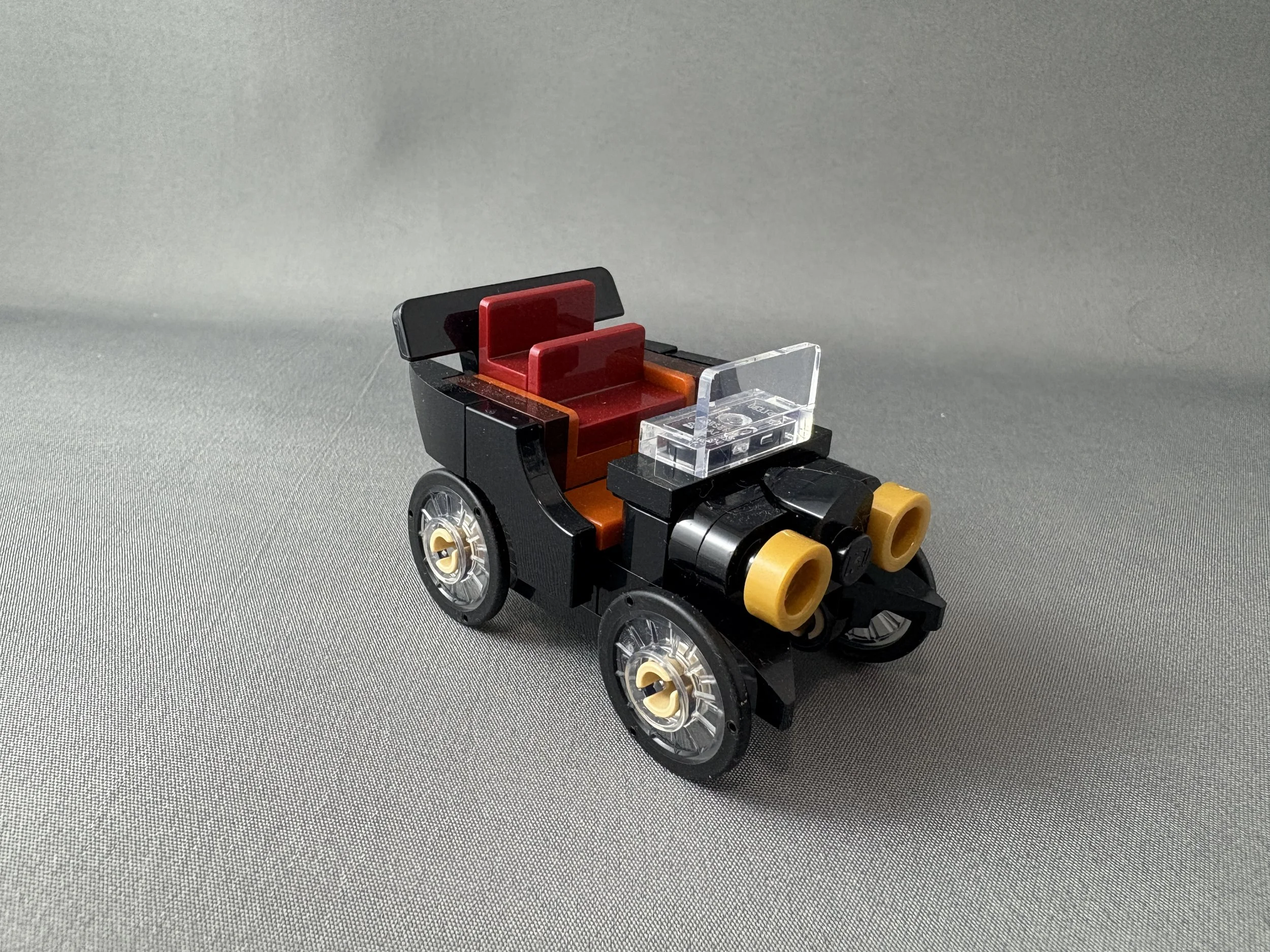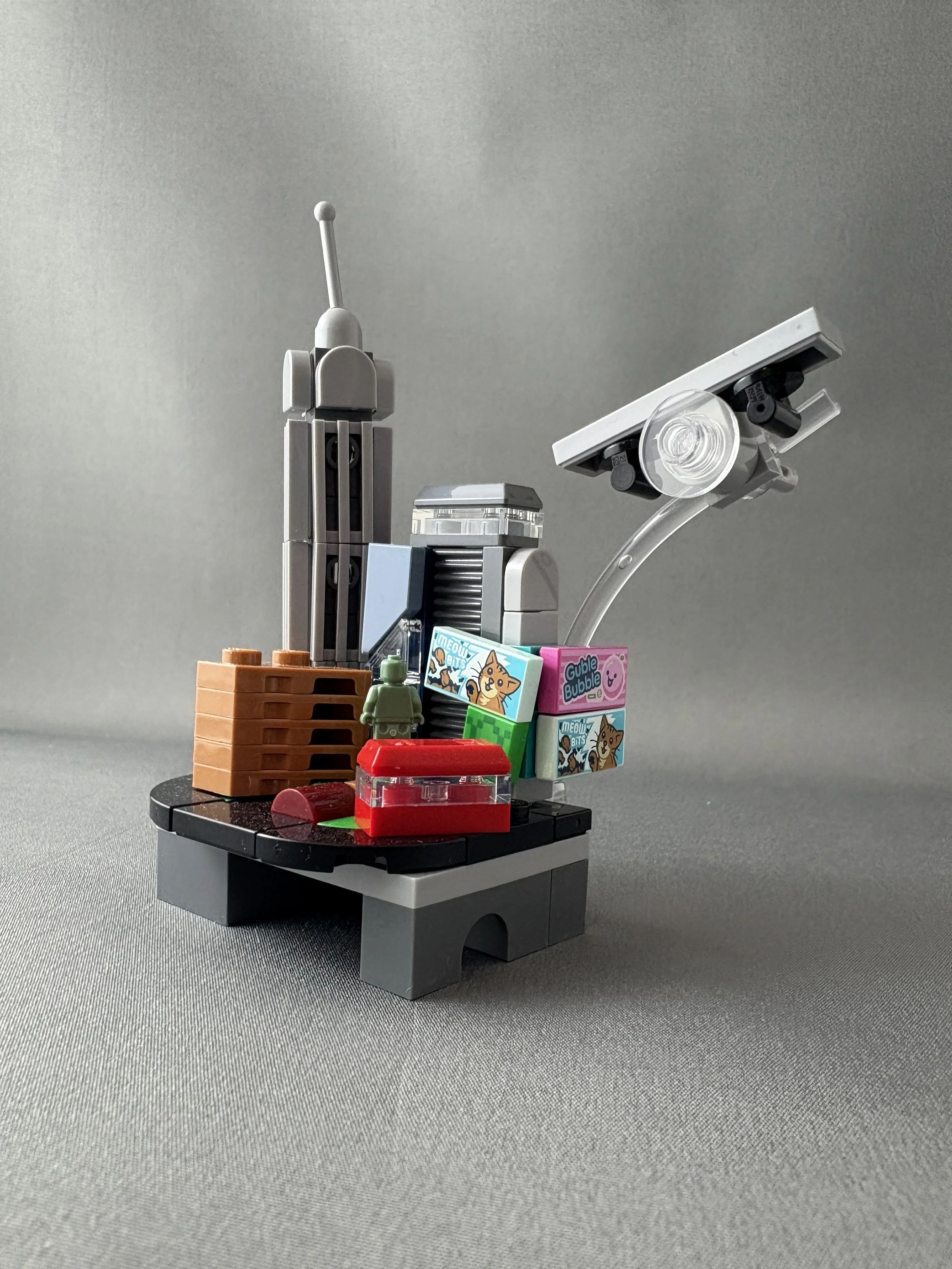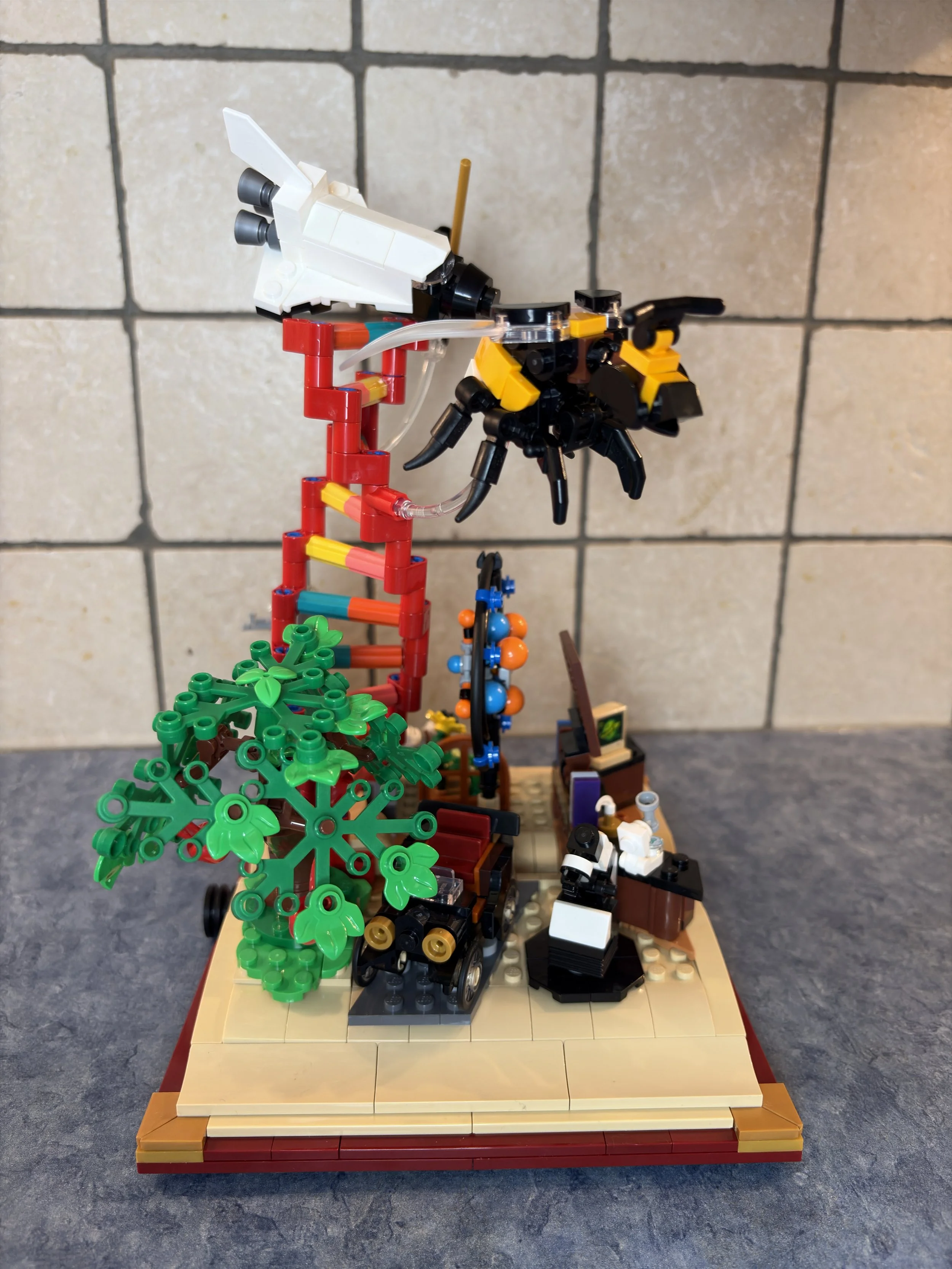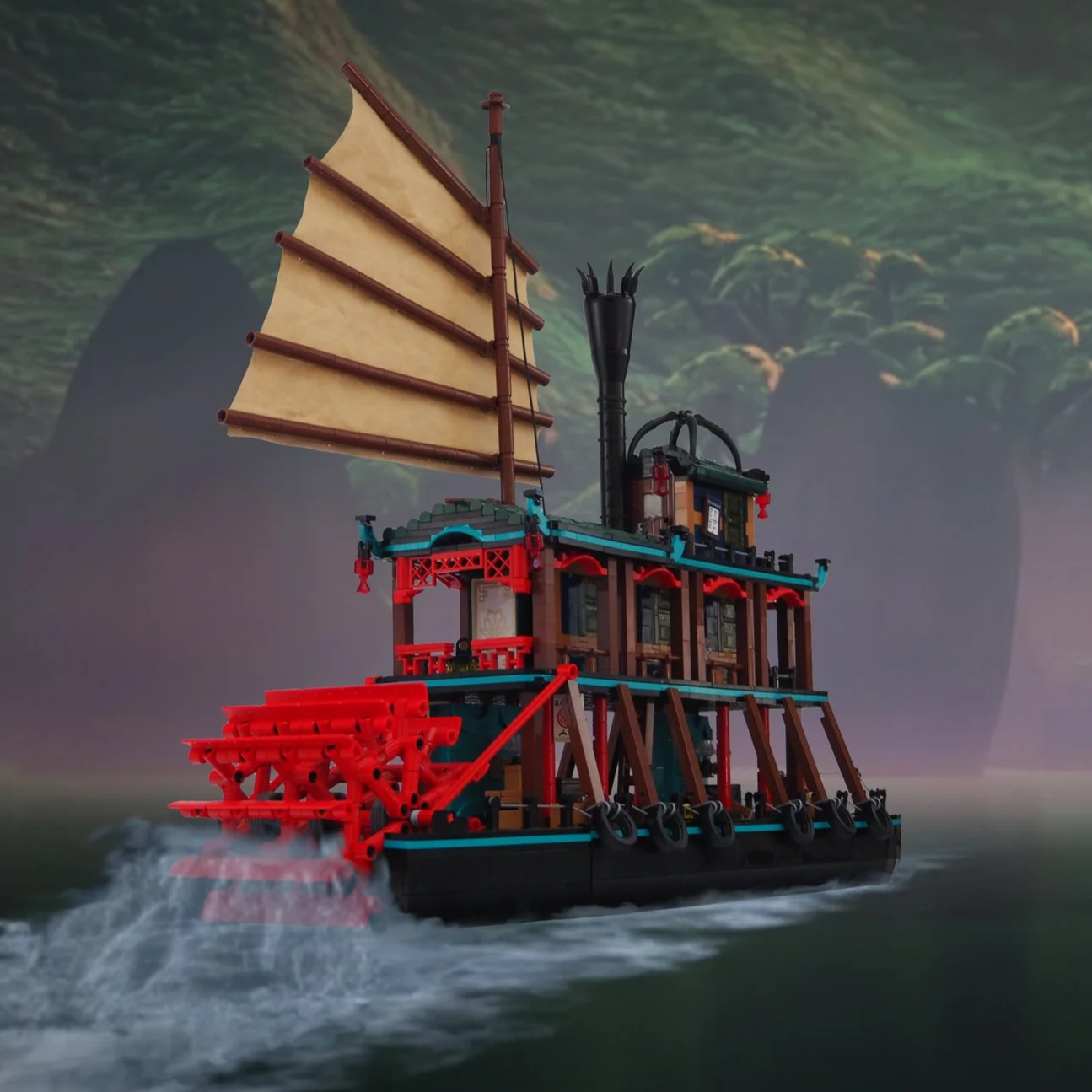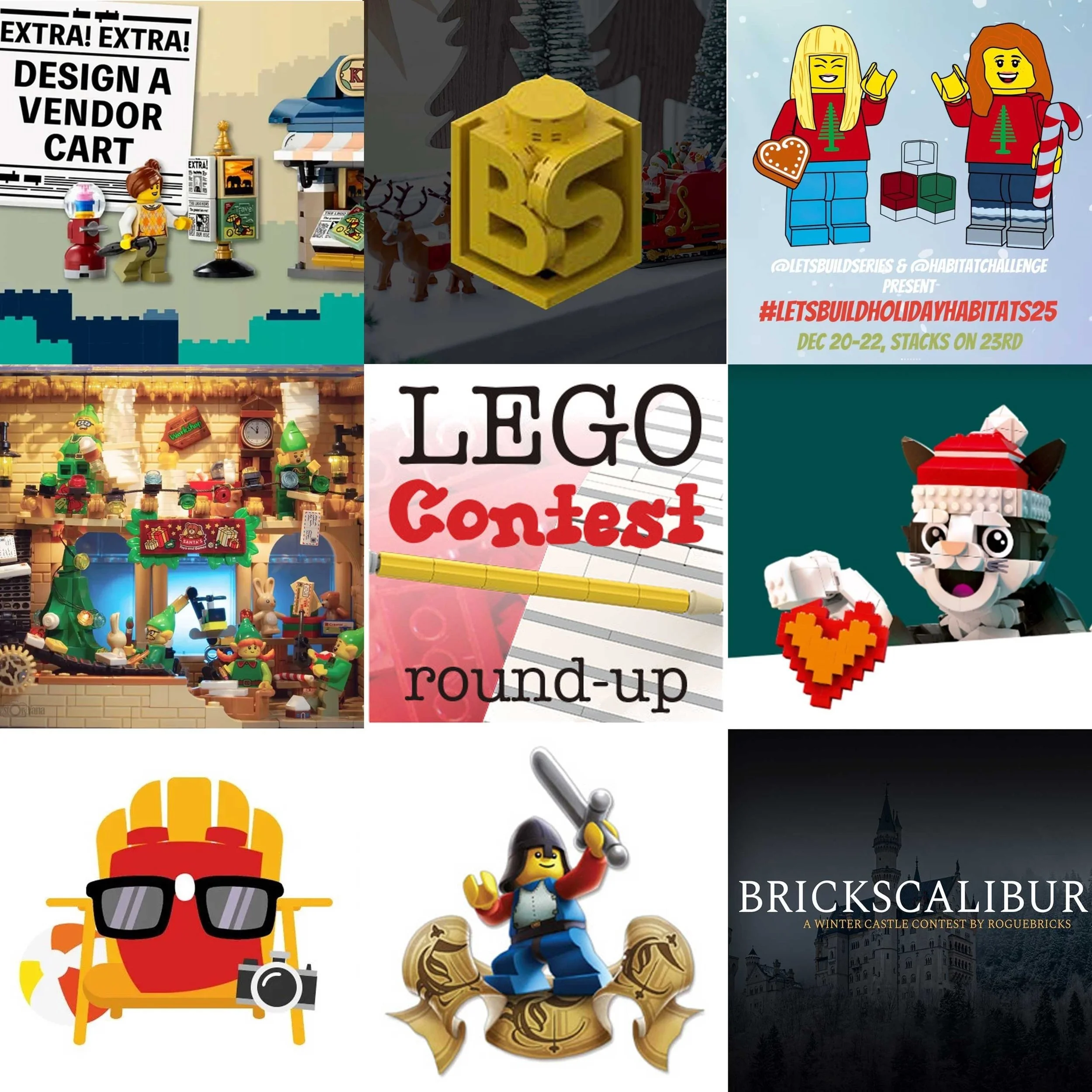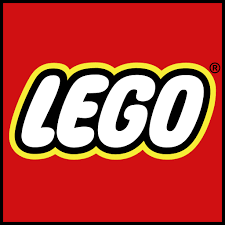LEGO, Learning and STEM: Unpacking How We Learn
/What do Marie Curie, Sir Isaac Newton, and George Washington Carver have in common? They’re all scientific trailblazers—and now, they’re minifigures in one of LEGO’s most inspiring sets yet. The Evolution of STEM, the winner of the 2023 LEGO Ideas contest Celebrate the Wonders of STEM, will release on March 1, 2025. But don’t let the sleek box art fool you—this set isn’t just about building; it’s about celebrating curiosity, innovation, and the interconnected worlds of science, technology, engineering, and mathematics.
I personally connect to this set being a teacher at a school that encourages the STEM field. (In all actuality, this set should be called The Evolution of STEAM since LEGO in itself is Art.) So join me as we dive into why this set is more than meets the eye and how it reflects learner profiles from an educational viewpoint. Along the way, we will speak with the designers of the model and learn a about a few hidden details along the way!
So class, crack open your books because we are about to begin.
What is STEM?
Before we crack open the pages of this metaphorical pop-up book, let’s take a moment to answer the obvious question: what exactly is STEM? According to The STEM International Academy of Canada, it stands for Science, Technology, Engineering, and Mathematics—an interdisciplinary approach that blurs the lines between traditional subjects to create richer, real-world learning experiences.
Instead of learning each one of these subjects separately, deeper learning happens when these curricula are intertwined and overlapped, because, after all, they all do overlap in reality. So why teach them separately?
But The Evolution of STEM doesn’t just represent these disciplines; it embodies them. Think of the set as a three-dimensional love letter to discovery, curiosity, and learning.
A Pop Up Book Bursting with Ideas
When I first saw this set I first thought it looked like if a LEGO Ideas set and a BrickLink Designer Series set had a baby! It could be just a coincidence because ideas can come from anywhere, but this is where my brain went. Although the ideas are different, the concept is the same.
my mind did this: imagine it, build it + any previous pop-up book = the evolution of stem.
I could not help but think this set reminded me of a few builds very familiar to me: Jason Allemann and Grant Davis’s Pop-Up Book, Paul Hetherington’s Mouseguard and Imagine It, Build It, and the Hans Christian Andersen Pop-Up Book set.


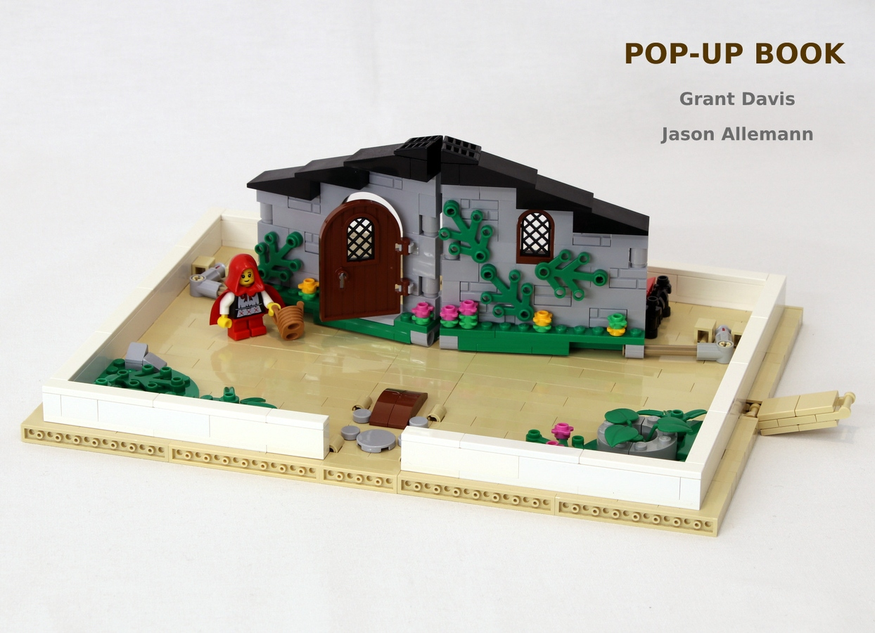
Inspiration must come from somewhere, right? Inspiration breeds inspiration, which in turn, breeds inspiration. What do we get out of it? Some fantastic builds! I asked Paul where he got his inspiration for his Mouse Guard pop-up book MOC and he immediately said Nathan Sawaya’s Castle Pop-Up Book, pictured above.
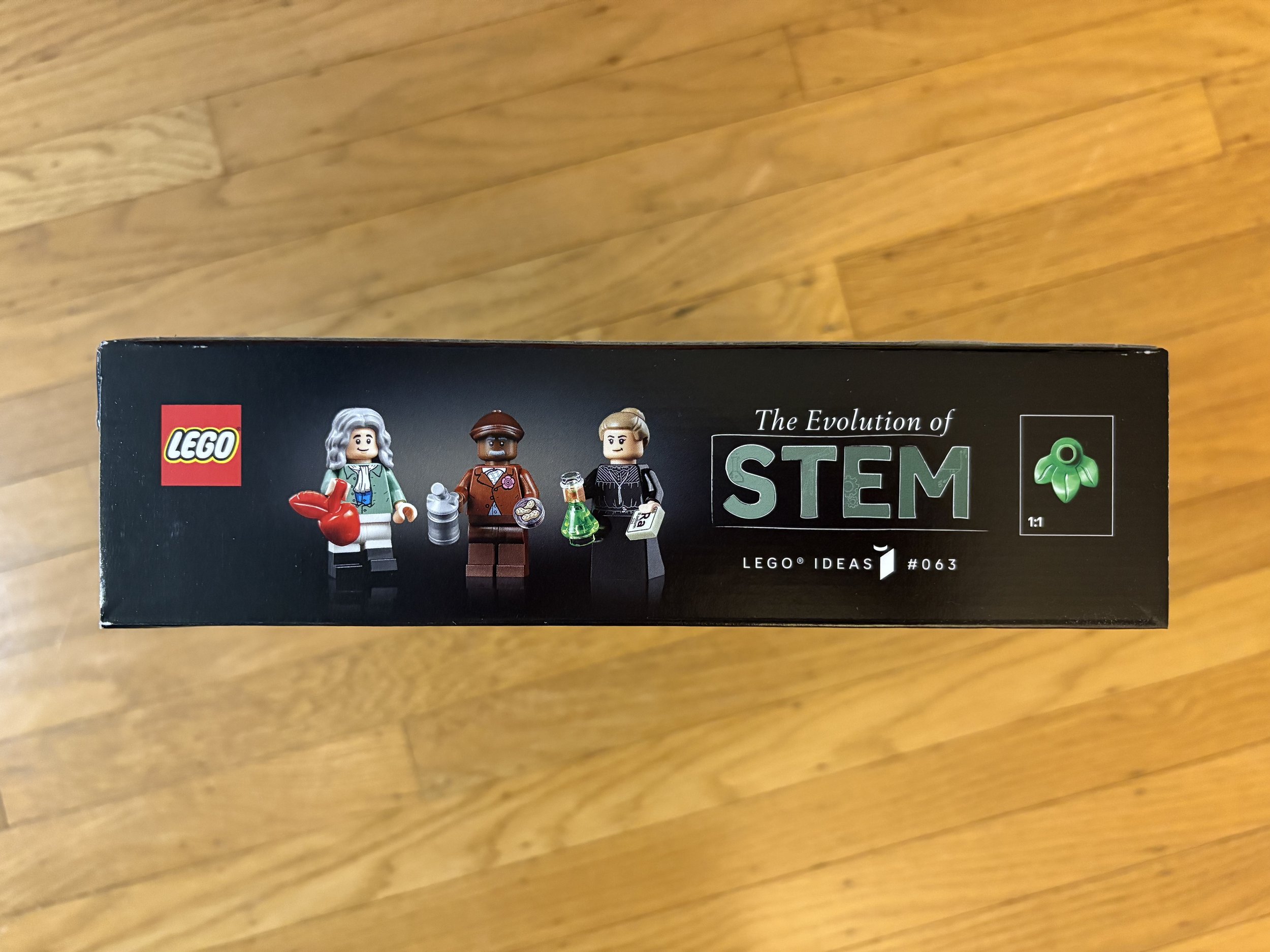
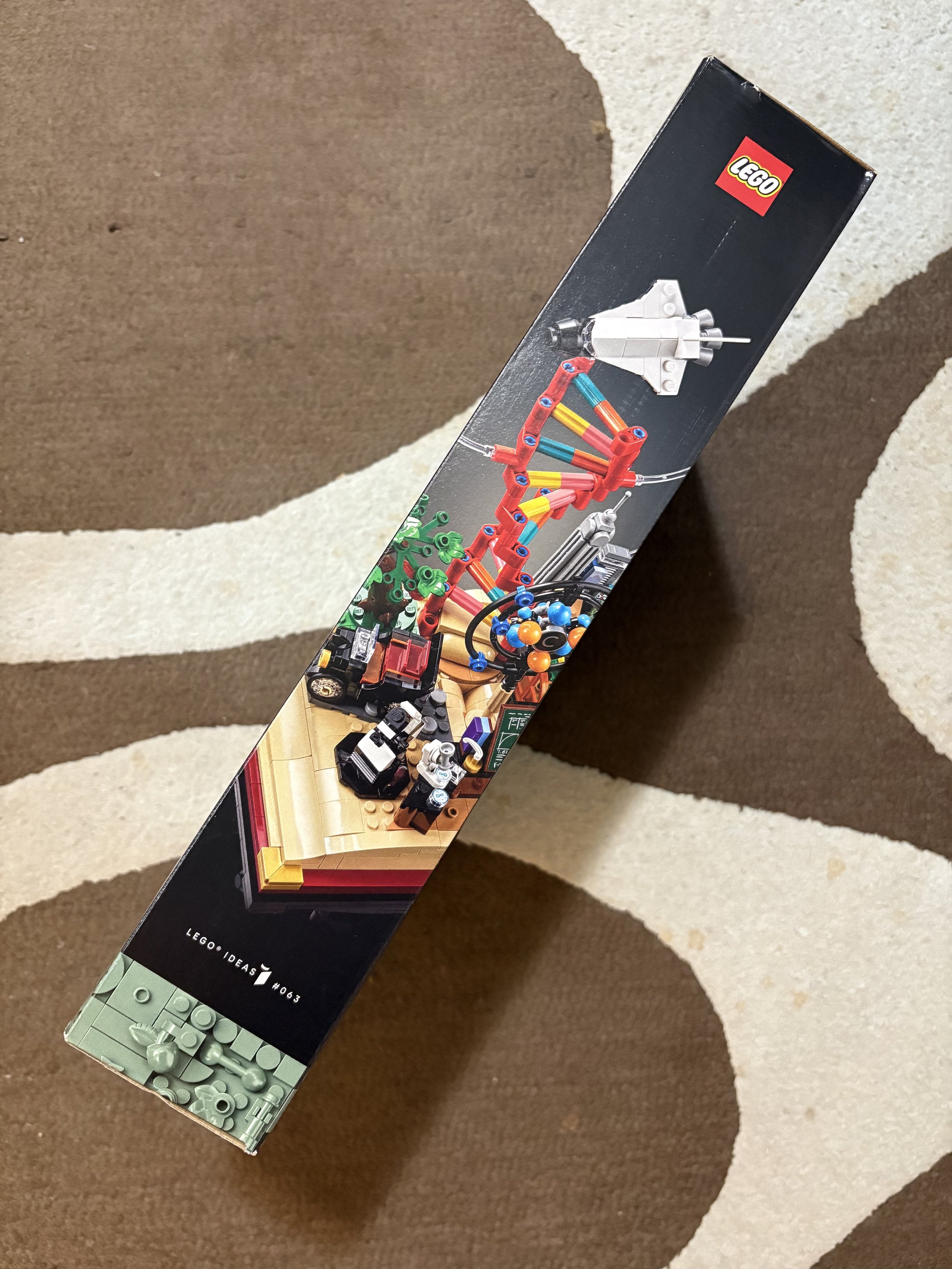
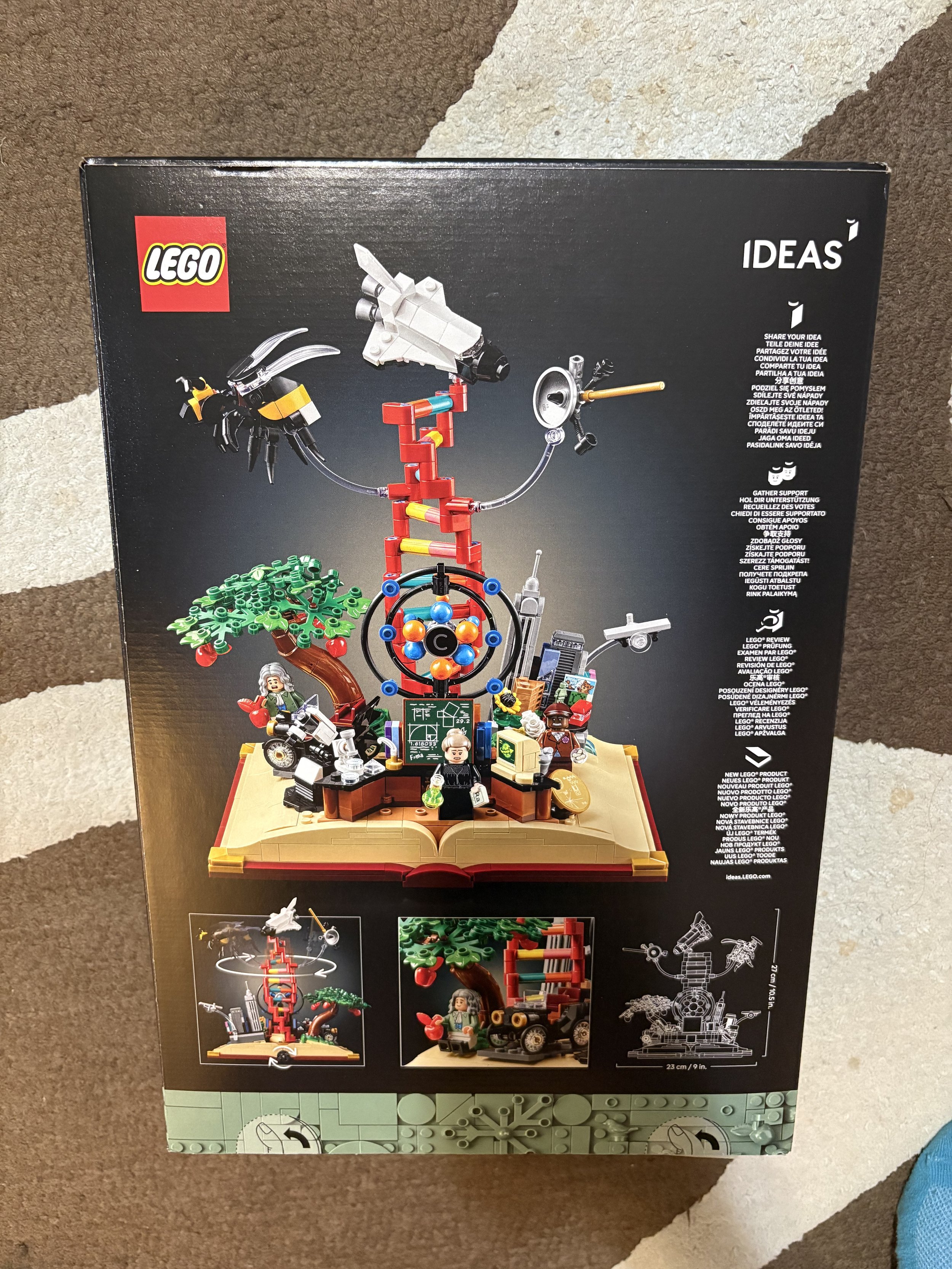
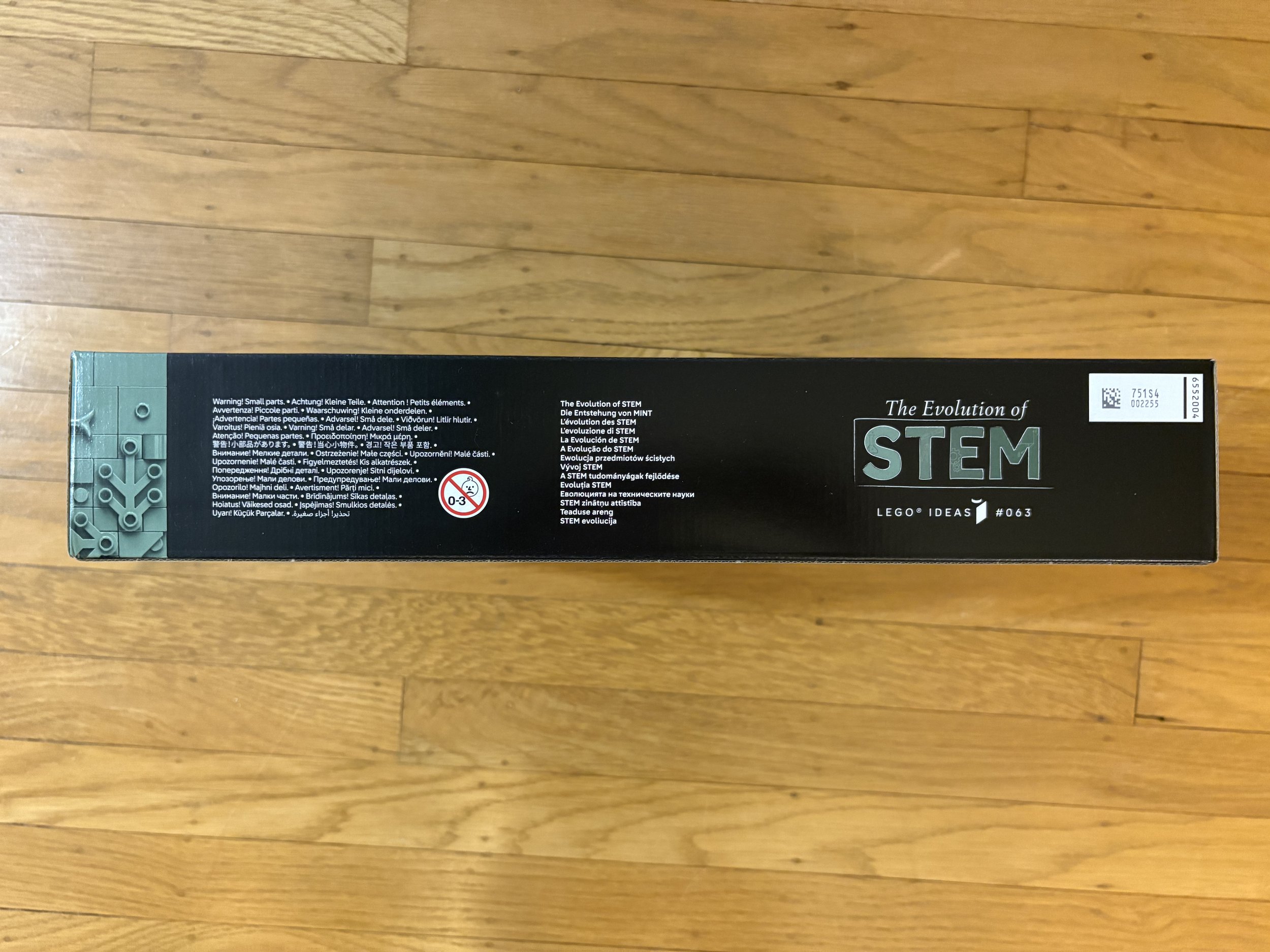
Building The Evolution of STEM is like taking a hands-on journey through the history of scientific discovery. Each section offers a fresh experience, from assembling the intricate DNA strand that spirals through the model’s core to crafting miniature lab equipment and detailed scenes representing key moments in science. The surprises tucked within—like hidden Morse code messages and a glow-in-the-dark radium tile—really made me smile as I built the set.
The Thinkers Behind the Design
The original fan design, Knowledge Is Power by Daniel Bradley, started as a clever concept of ideas bursting from the pages of a book. It was a fun design, and I can see why it won the contest.
photo credit: daniel bradley. knowledge is power is daniel bradley’s origional submission for the lego ideas contest, Celebrate the Wonders of STEM.
The final product looks quite different from the original idea but uses a lot of the same concepts (and even includes some spinning DNA). While the original concept only had 528 pieces, LEGO designers Jordan Scott and Ollie Gregory expanded the idea into a dynamic 879-piece set that kept the heart of Bradley’s concept alive.

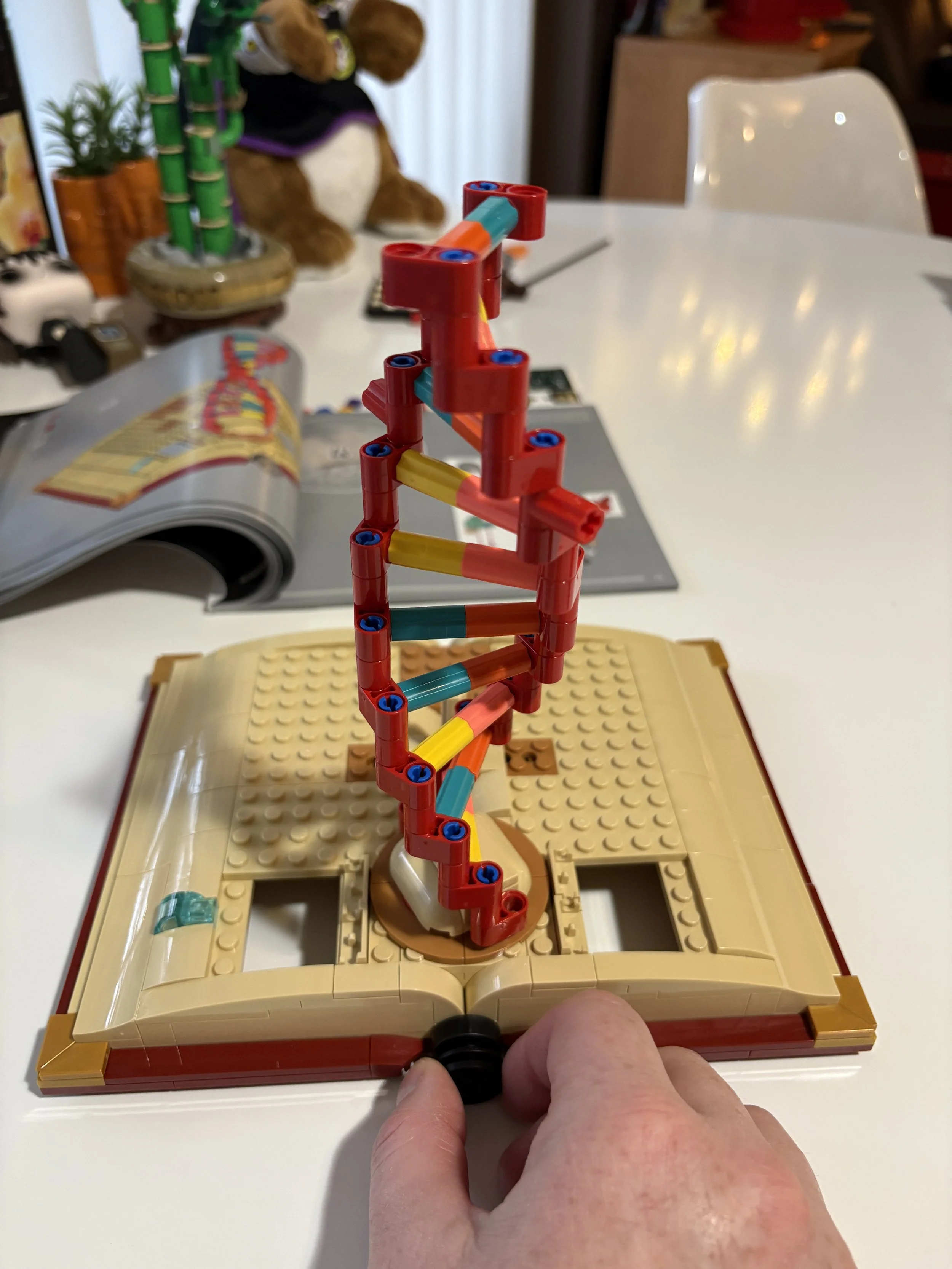
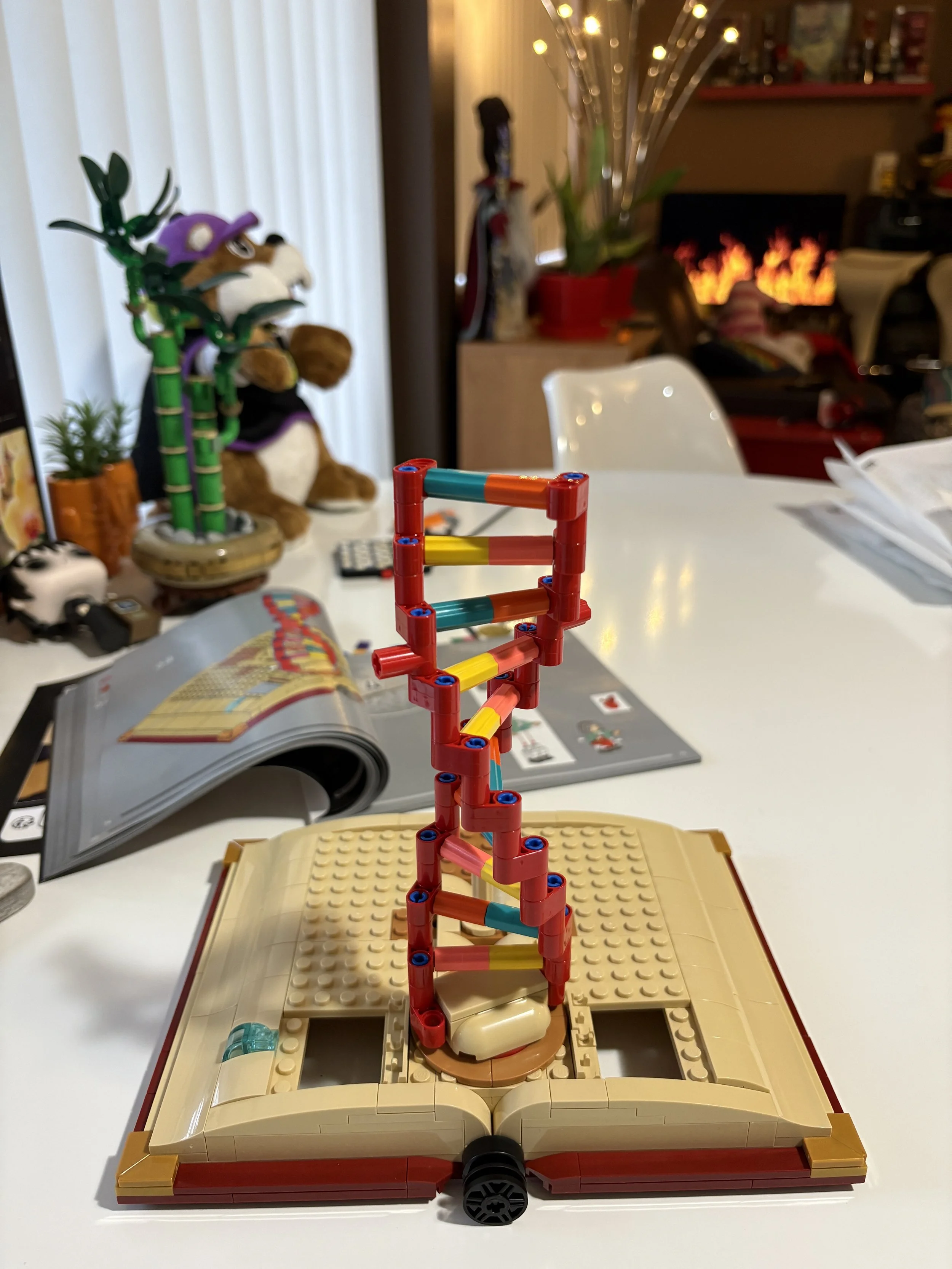


I had the chance to chat with the designers about the set so I cheekily used my time to ask firsthand about the DNA spinning backward. It was a lighthearted question and I did get a giggle from one of the designers. It was worth it.
Melissa: Before a set is released, do you have a subject matter expert review the set for accuracy?
Ollie Gregory: The great thing about LEGO design is we have so many designers from so many different backgrounds. We have a couple of ex-teachers, science teachers, and a professor or two.
Jordan Scott: And pretty much a paleontologist as well.
Ollie Gregory: We did share it with some people and asked what they thought. The DNA thing is very interesting. We completely missed it. So I’m going to say it’s “Z-DNA” rather than A or B-DNA, which we all know rotates the opposite way to conventional DNA. It’s a completely ambidextrous build so if you want it the other way, you can just turn it that way. The awesome thing about DNA is we’ve provided the pieces to make one DNA, but nothing is stopping you from extrapolating it out and building your entire genome if you’ve done an ancestry test and want to replicate it.
dna. any way you want it.
Jordan Scott: There was one expert that we had to talk to specifically about a very specific detail in the set… and that was Zeus the cat. That’s Dan’s cat—he’s the little easter egg on the meow bits tile. I’d say he was the top professor we had to check in with. This is the first set we’ve had a cat’s approval on.
Daniel Bradley: He approves.
Everyone: (Giggles)
these meow bits tiles are zues (dan’s cat) approved! these are one of the many easter eggs in this set.
Melissa: For the LEGO Ideas platform, what are some considerations when designing the final model? Apart from the obvious ones like structural integrity, part count, size, and part availability.
Jordan Scott: We always try to include what we refer to as surprise and delight. That’s something you might not see on the fan submission, but when you’re building it, it’s either through the experience of the building instructions or something you find along the way. Those pages of the book are a very good example. We don't have to include those. We're adding pieces and complexity to the build, but it’s a nice little surprise that you would find along the way. It gets people talking—it’s a conversation piece.
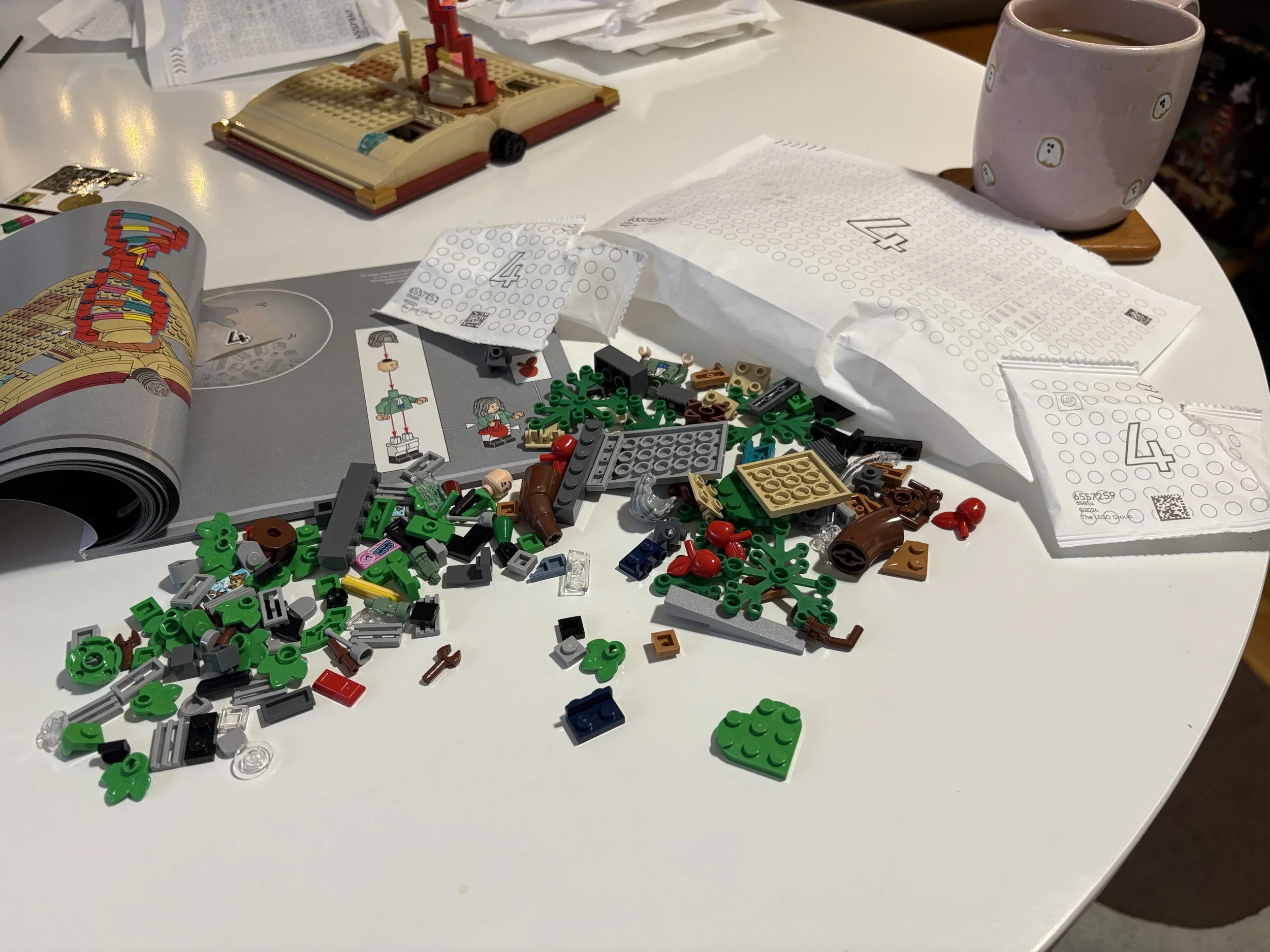
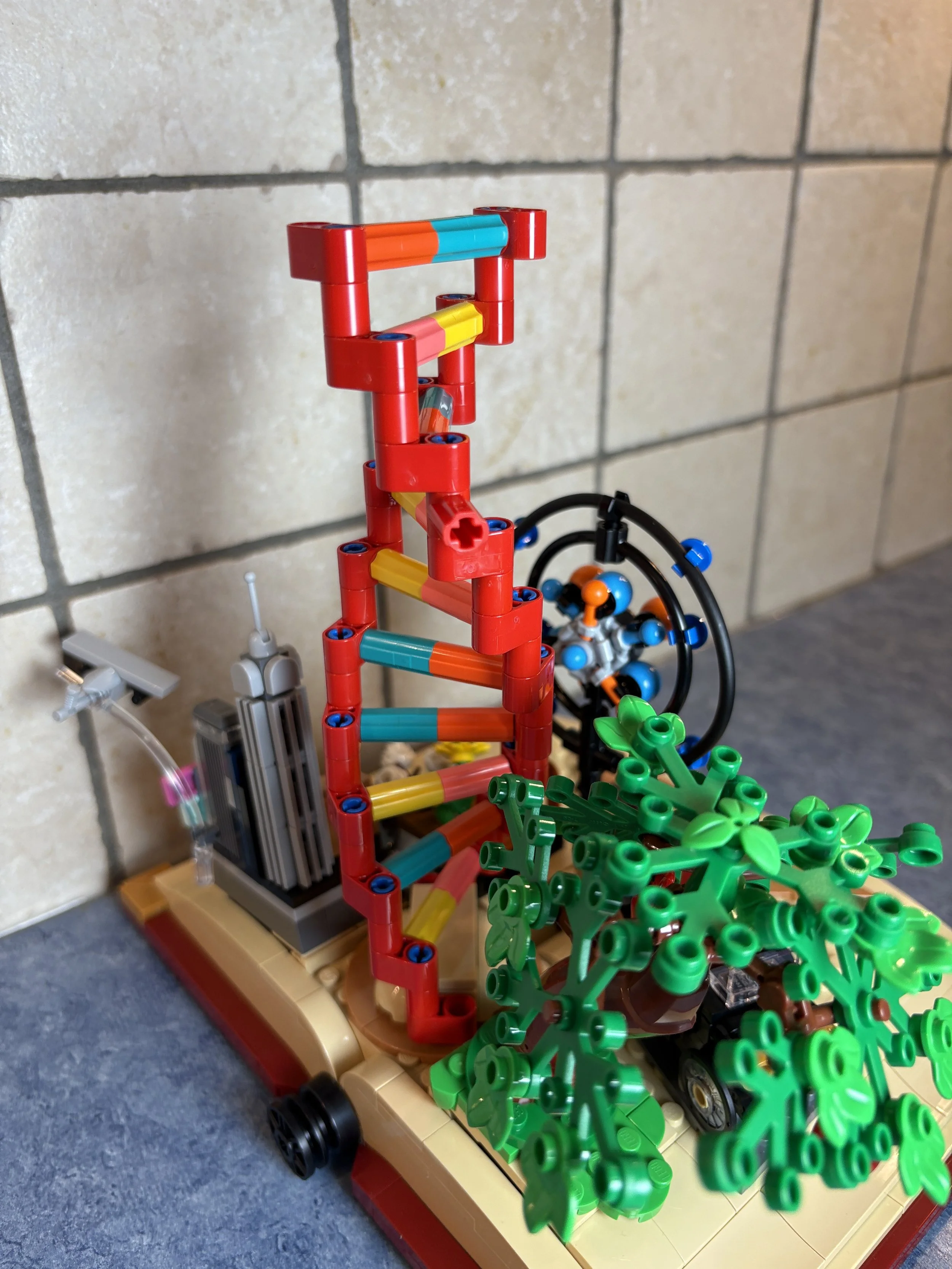
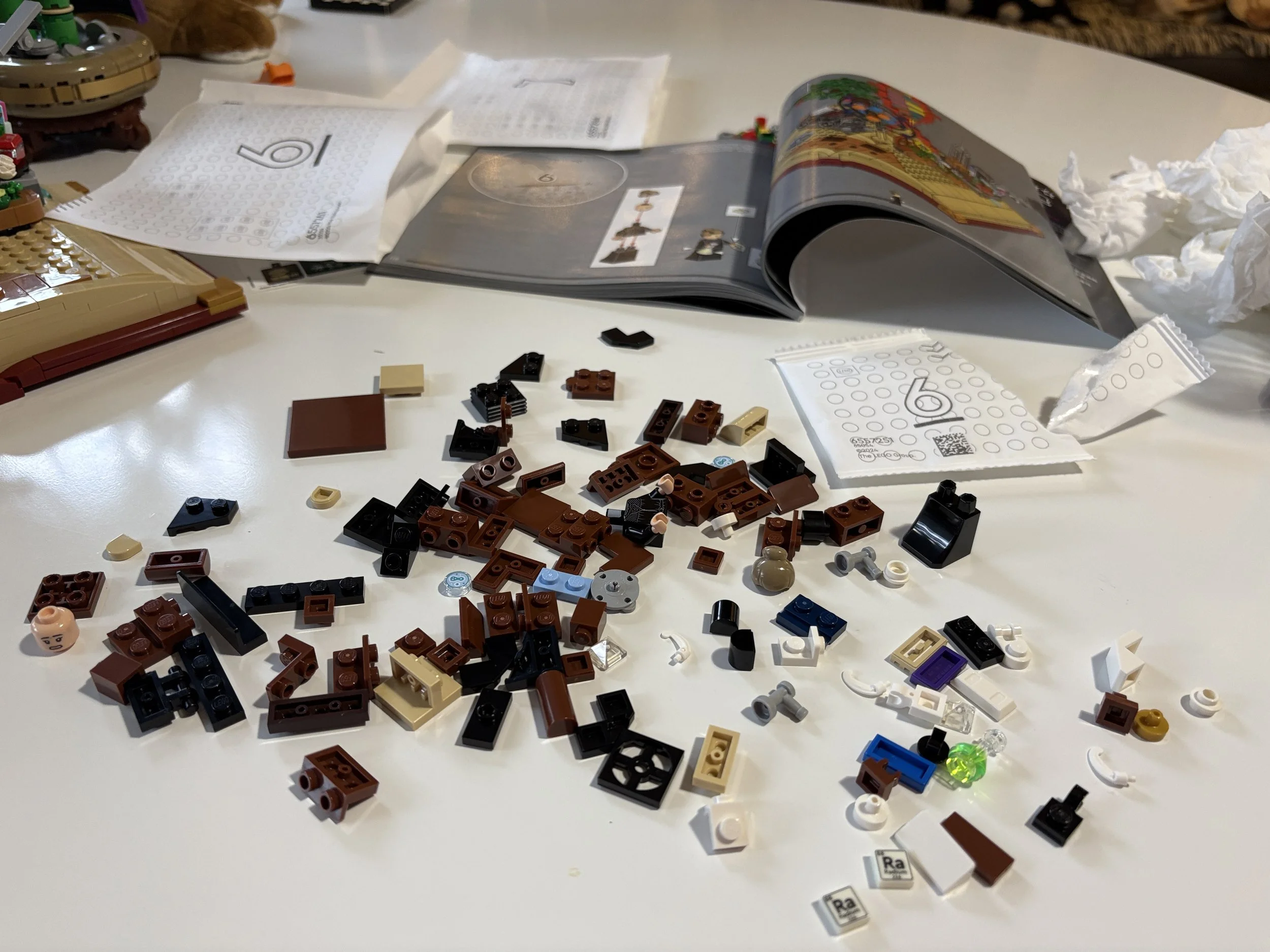
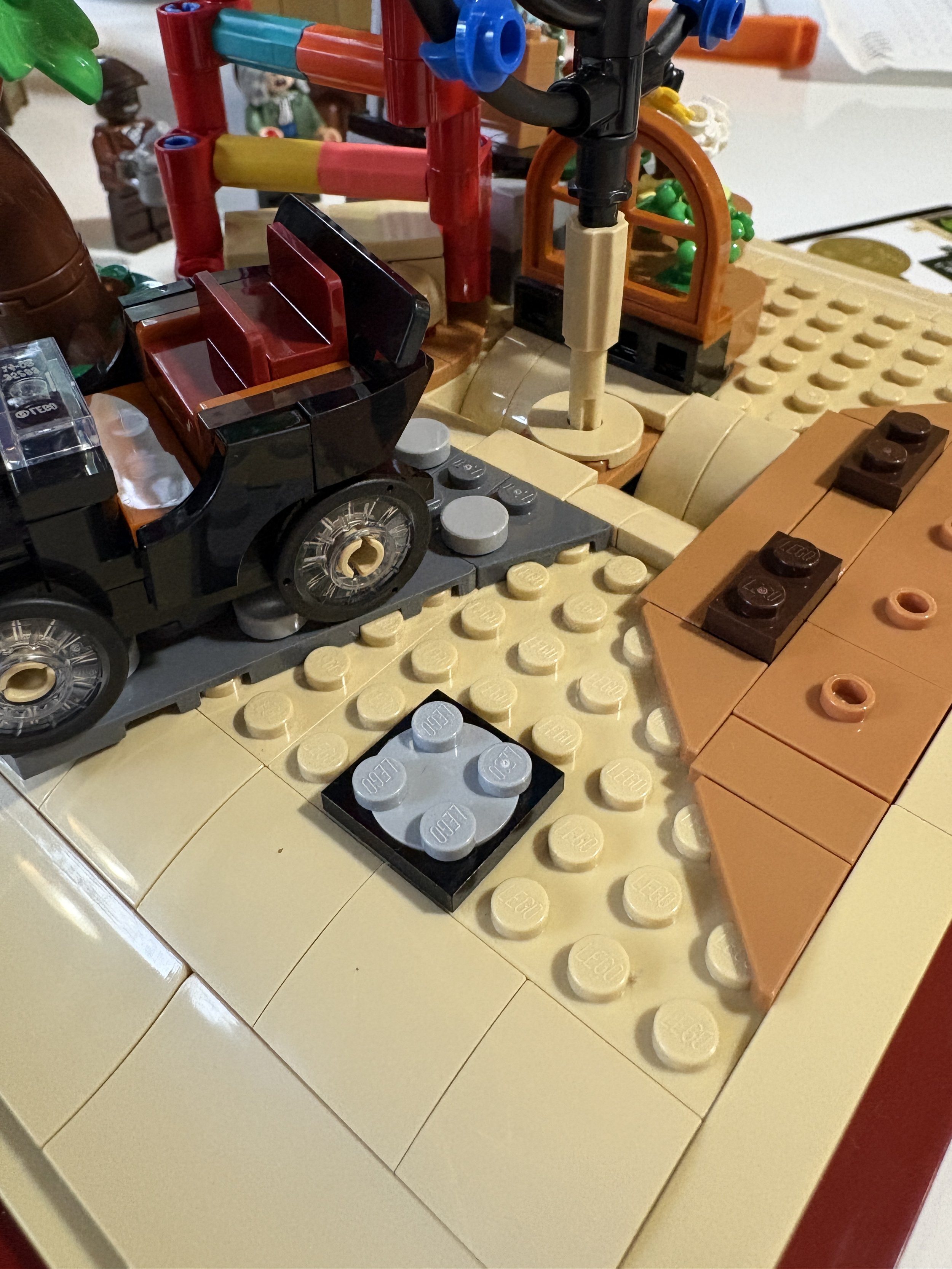

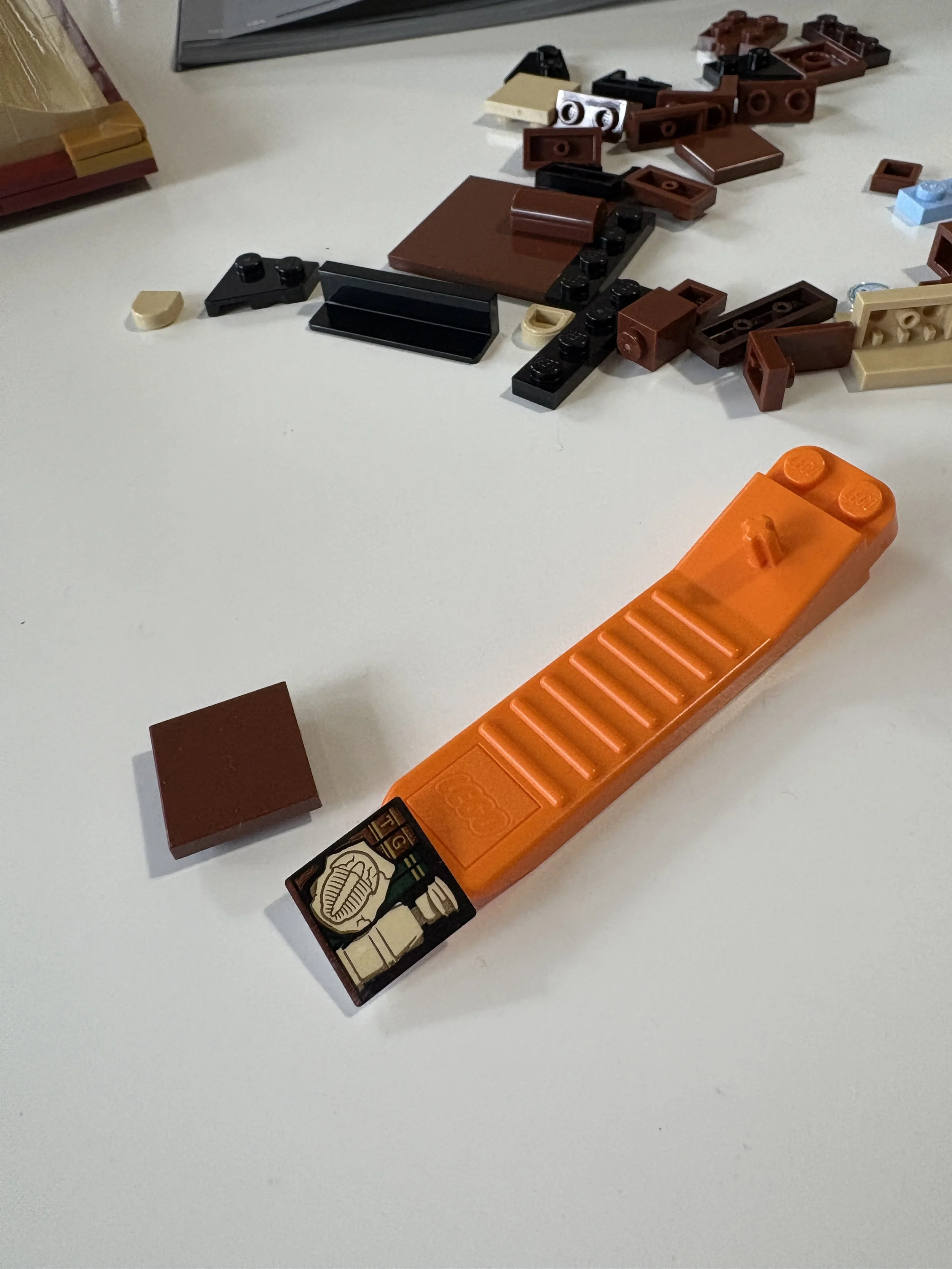
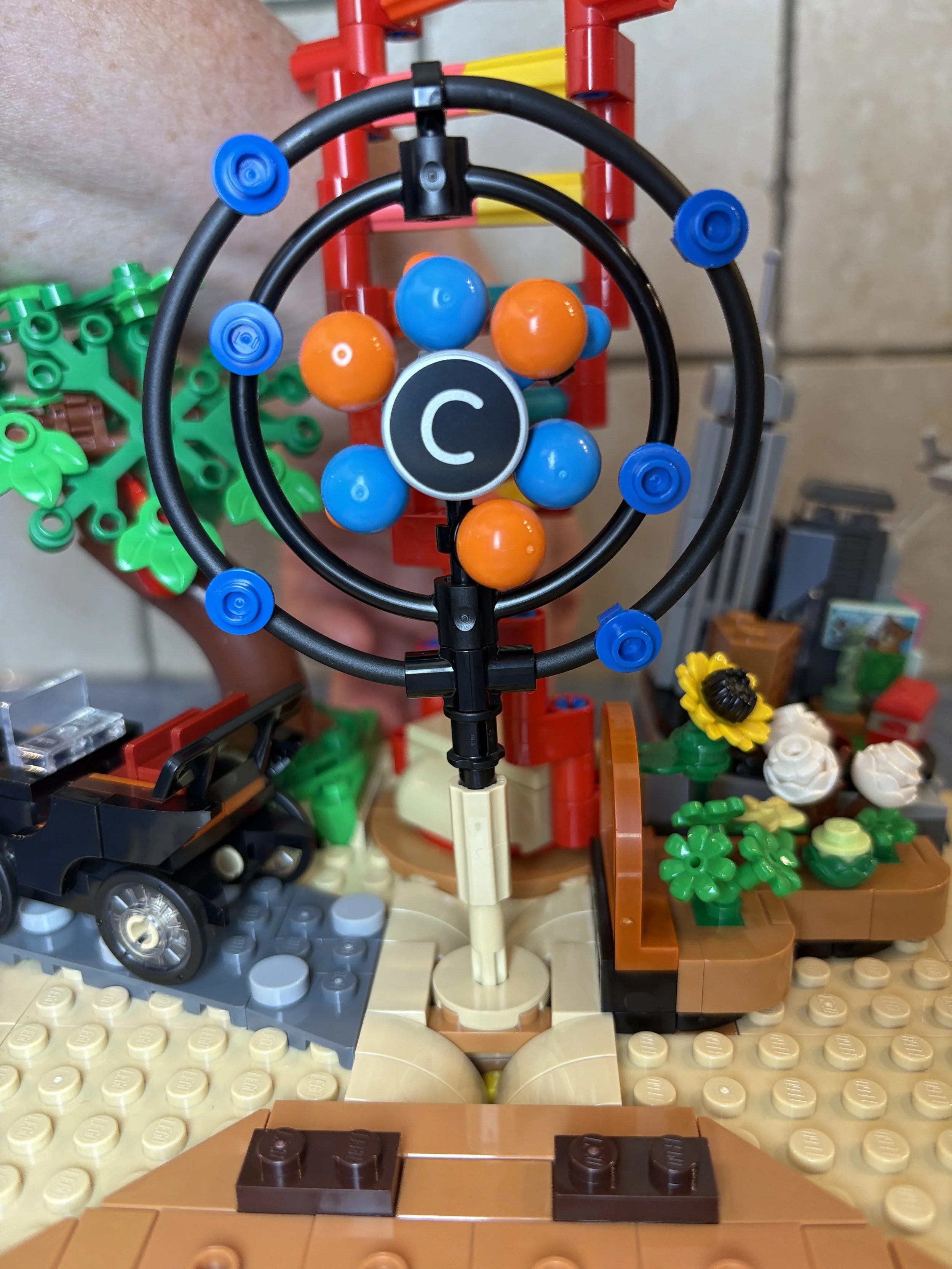
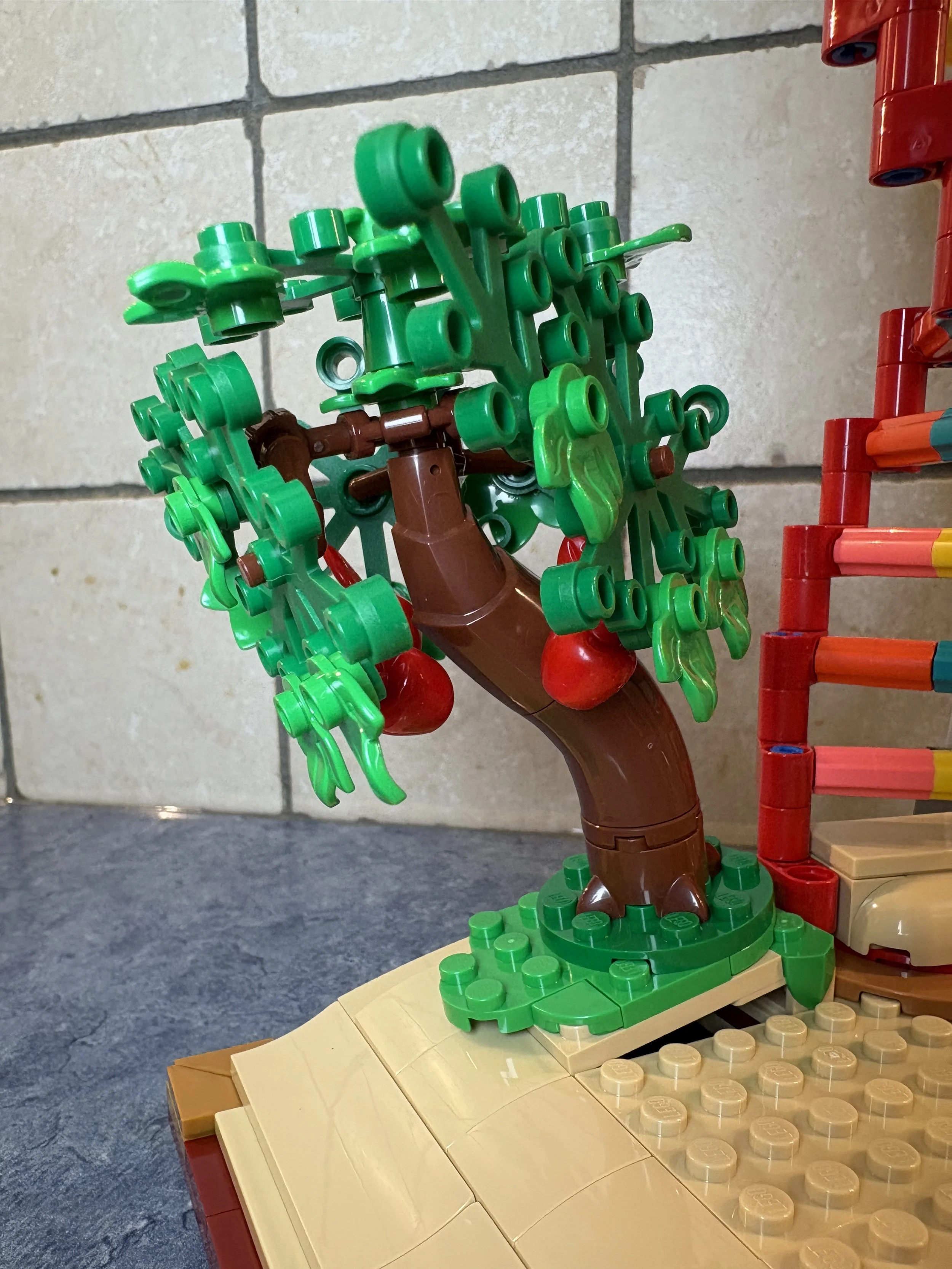

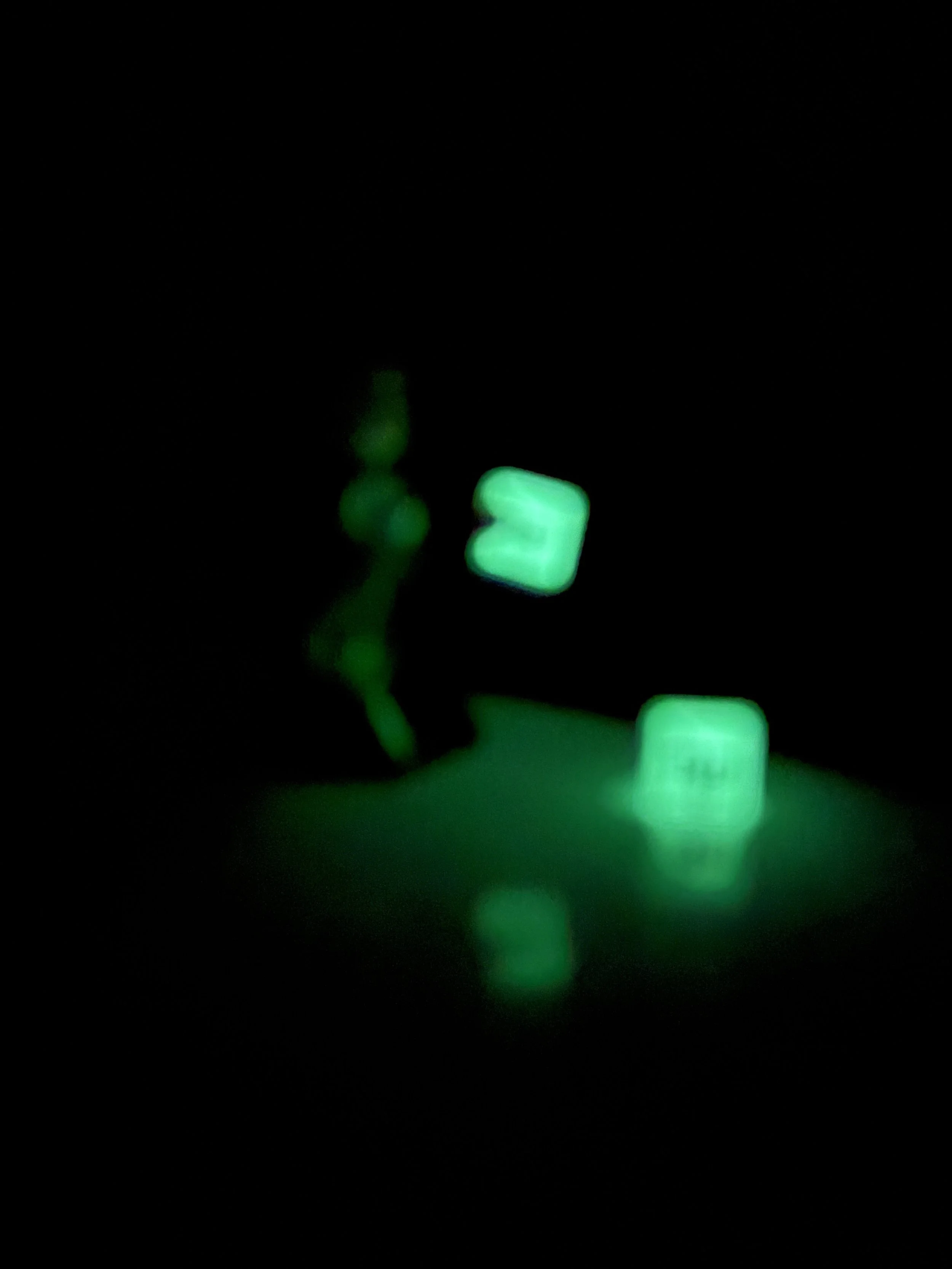
Melissa: Did this set have any specific design challenges that were unexpected?
Ollie Gregory: The DNA strand was the biggest challenge—I spent the most time on it. Existing pieces just weren’t cutting it, so we developed a new two-module beam with a cross axle in the middle. The Technic Systems relies on a grid, but we wanted something different: half-grids with solid structural integrity. Creating that element was a lot of fun, and the best part? This DNA design is so strong, you could extend it a mile, and it still wouldn’t come apart.
the dna of it - do you like the new part?
Jordan Scott: There was also a structural issue because there was a different animal included before we arrived at the bee. We wanted to do a blue whale to represent the sea. But it was so heavy that it tilted the entire DNA strand, so we went with the bee instead. Bees are endangered and they’e crucial to the environment. So it did make sense, and it also flies, whereas whales don’t.
Ollie Gregory: And they’re builders.
Jordan Scott: So it all made sense, but it was a shame to lose the whale. But that’s how it is. Let’s see what the future brings. We might get the whale back.
LEGO, Education and the IB Program
i am really proud of what i have created through lego club. starting a club like this from scratch and keeping it running like a well oiiled machine is a tonne of work. but it’s worth it!
As an Educational Assistant, The Evolution of STEM set resonates deeply with me. I can already picture it proudly displayed in our school’s hallway, right alongside the incredible builds from our LEGO club—a club I started from scratch. The excitement will be contagious, sparking creativity, curiosity, and endless conversations among students.
I can already imagine the buzz this model will generate as students gather around, inspired by its design and the scientific achievements it celebrates. It might even be the perfect catalyst for a school-wide build contest to see what new ideas this set can inspire.
i might be biased, but lego club is my favourite part of my job. on those days where everything feels like a struggle at work, this is what keeps me going.
photo credit: ibo.org. this is the ib world schools logo. i recommend looking it up to learn more about education system and the possibilities surrounding it.
I work at an International Baccalaureate (IB) Elementary School, a program designed to give students more autonomy over their learning. This approach empowers them to explore subjects in ways that foster focus, curiosity, and deeper understanding. At the core of the IB program are 10 Learner Profiles, which guide both teaching and personal development: Inquirer, Knowledgeable, Thinker, Communicator, Principled, Open-Minded, Risk-Taker, Balanced, and Reflective.
In the sections ahead, I’ll explore how The Evolution of STEM connects with each of these learner profiles, but first let’s take a look at the minifigures included in the set.
Minifigures of Science and the IB Learner Profiles
let’s take a moment to appreciate the three historical icons brought to life in minifigure form. These pioneers—Marie Curie, Sir Isaac Newton, and George Washington Carver—helped shape the scientific landscape we know today. Their contributions continue to influence how we learn, innovate, and explore the world around us. We have a lot to thank them for.
George Washington Carver stands out as a symbol of the Knowledgeable profile (more on that soon). As a groundbreaking chemist, agriculturist, and humanitarian, Carver made extraordinary contributions by discovering hundreds of uses for peanuts, sweet potatoes, soybeans and pecans. In this set, the garden and tree elements symbolize his commitment to horticulture and his deep understanding of the cycle of life.
if you’re a fan of peanuts, you can thank george washington carver for creating over 300 different uses for the peanut. mmm, peanuts. this makes me crave a pb & J sandwich.
Marie Curie, a true Risk-Taker, broke barriers in physics and chemistry through her revolutionary research on radioactivity and her discovery of radium. The set captures her legacy perfectly, featuring a minifigure holding a glow-in-the-dark radium tile and a decanter—a fitting tribute to her groundbreaking scientific achievements and her historic recognition as the first woman to win a Nobel Prize.
the greats! Sir Isaac Newton, marie curie, and George Washington Carver. also, that radium tile that glows in the dark. yes, please! i was pretty excited to get a second one in the set!
Sir Isaac Newton, another brilliant Risk-Taker and Thinker, forever changed our understanding of physics and mathematics. His laws of motion and contributions to color theory transformed how we see the world—literally and figuratively. In the set, Newton is portrayed with an apple, a playful nod to the legend of his “eureka” moment of discovery..
These three scientific icons embody every aspect of the IB Learner Profiles: Inquirer, Knowledgeable, Thinker, Communicator, Principled, Open-Minded, Risk-Taker, Balanced, and Reflective. They were once curious learners themselves, just like the students we teach today. I often wonder—who among today’s young builders will grow up to be the next Curie, Newton, or Carver?
The Learning Profiles, LEGO and STEM
The Evolution of STEM isn’t just a celebration of science—it’s a hands-on embodiment of the IB Learner Profiles in action. Each element of the set connects to core educational values, encouraging builders to think critically, explore new ideas, and deepen their understanding of the world. Let’s take a closer look at how this set reflectsthese profiles.
Learner Profile: Inquirer
At its core, the Inquirer profile celebrates curiosity and the joy of discovery—two things this set captures beautifully. The book-shaped base of The Evolution of STEM is a perfect metaphor for where inquiry begins: with a thirst for knowledge. Just like students eagerly peering through a microscope in the school library, this set invites builders to look closer, explore deeper, and ask questions that go beyond the obvious.
the microscope = deeper learning. this is how you see more than meets the eye.
For me, it sparked memories of my own Grade 10 science class, a time filled with curiosity, independent learning, and hands-on experimentation. Science labs and libraries are the perfect place for being curious and independent. Every element of this set—from the scientific tools to the hidden Easter eggs—encourages builders to dive into the unknown with enthusiasm and creativity.
Learner Profile: Knowledgeable
Being Knowledgeable means developing a deep understanding of ideas across different disciplines and engagin with issues and ideas with lobal and global significance—and that’s exactly what this set inspires. As an educator, I am addicted to learning new things. I found myself falling down research rabbit holes while building—reading about DNA structures, re-exploring the life of George Washington Carver, and marveling at the complexity of atomic models.
The questions this set raised for me made me giggle. It reminded me of being at any location in the school really, where questions are constantly flying at me about anything and everything all day long. I felt like a little kid again bursting with questions as I built. It was a nice, familiar feeling.
the carbon atom. life itself.
The carbon atom replica in the set is the perfect representation of this profile. It’s a reminder that everything on Earth, including us, is made of atoms. The set’s original title, Knowledge Is Power, couldn’t be more fitting—it distills vast scientific concepts into a fun, hands-on learning experience. Every brick feels like a small piece of a much larger puzzle, making STEM concepts tangible for both kids and adults. The set is knowledge in a nutshell, or in this case a LEGO shell.
Learner Profile: Thinker
The Thinker profile encourages creative problem-solving, critical analysis, and taking responsible action on complex problems—skills that have driven humanity’s greatest scientific advancements. This set embodies that spirit through thoughtful design choices, from the intricate DNA helix to the miniature science lab and NASA telescope. The thinker-learner profile is what got us to where we are today in society. The advancement of human life through technology, science, math, medicine, and everything we have today has come from thinking and putting great minds together.
As we encourage deeper thinking through the IB concept, we encourage the advancement of the human species and the world around us. As I built, my imagination ran wild. The possibilities felt endless—what other pop-up scenes could I create? A garden blooming from the pages? A cityscape unfolding in miniature? The set doesn’t just encourage building; it sparks deeper thinking about how science, technology, and creativity are interconnected. It’s a model that doesn’t just engage your hands but challenges your mind to explore new ideas.
Learner Profile: Communicator
Effective communication is at the heart of both science and education—it’s how ideas are shared, discoveries are made, and collaboration thrives. As educators, we spend our days modeling communication, both verbal and non-verbal, teaching students to express themselves clearly, listen actively, and engage thoughtfully with others’ perspectives (sometimes to the point of not being able to communicate at the end of the day because our mental batteries have drained and need recharging).
In The Evolution of STEM, the Communicator profile comes to life in a clever, interactive way: Morse code. Hidden within the book base of the set, this sequence of dots and dashes challenges builders to decode its secret message, engaging both problem-solving and curiosity. If one dares to explore the ‘pages’ at the base of this book, they will discover what the code says. Don’t worry, no spoiler alerts here!
in this image you see the optical light spectrum on one side and the morse code on the other. i had to decode the morse code, it fittingly says ____________. just kidding! no spoilers here, but i bet you can guesss what word the four letters creates.
The minifigures in this set—Marie Curie, Isaac Newton, and George Washington Carver—were also all master communicators in their own right, sharing groundbreaking ideas that transformed science and education. Their legacies prove that the ability to share knowledge effectively is just as important as the discoveries themselves.
Learner Profile: Principled
Being Principled means acting with integrity, fairness, and respect—values that shape both individual character and a healthy, functioning society. This can be one of the hardest lessons to teach, as it often involves doing the right thing when no one else is watching.
The three minifigures in this set embody this profile. Before becoming historical icons, Curie, Newton, and Carver were learners themselves, guided by values of honesty, responsibility, and respect. Just as educators strive to teach fairness and inclusion, these pioneers modeled what it means to act with integrity in their fields. Someone taught them to be principled early in life. Just like we teach students to be principled.
you may not even realize how principled you are intrinsicly being when you drive a car. many accidents come from people not being principled, respectful, or safe.
A thoughtful symbol of this principle within the set is the classic car build. Driving safely, maintaining responsibility for others’ safety, and respecting the shared space of the road all reflect how principled behavior applies in everyday life. What happens if you drive a car recklessly and hit something? Someone could get hurt. What happens if you don’t do maintenance on your car? It could (and will eventually) break down. Similarly, within schools and communities, being principled helps create a balanced, respectful environment where everyone can thrive.
Live in a shared accommodation building? Work in a shared building? Being principled is a good way to be a good-standing member of society. Just like the car, city, and minifigures in the model, the students and staff at the school are all practicing and learning how to be principled each and every day. Being principled creates a smooth-running society.
Learner Profile: Open-Minded
An Open-Minded learner seeks to understand and appreciate different perspectives, cultures, and experiences. In education, fostering open-mindedness encourages students to explore ideas beyond their own worldviews, helping them grow both intellectually and personally.
In this set, the car and airplane builds are symbols of open-minded exploration. The invention of cars in the early 1900s allowed people to travel beyond their immediate surroundings, expanding their understanding of different cultures and ways of life. The airplane took that concept even further, connecting people across continents and encouraging a truly global perspective.
Just as travel broadens the mind, schools offer students the opportunity to “travel” through books, discussions, and exposure to diverse viewpoints. The Evolution of STEM reflects this concept beautifully with the excitement of learning literally bursting out of a book.
Learner Profile: Caring
The Caring profile emphasizes empathy, compassion, and a commitment to making a positive difference in the lives of others. In schools, we foster this through programs like Second Step, which focuses on teaching cooperation, communication, and thoughtful decision-making. Just as importantly, we prioritize social-emotional learning for staff, recognizing the mental and physical challenges educators face in such a demanding profession. Being an educator has a high burn-out rate, so supporting both students and staff in developing a caring mindset helps build a stronger, more compassionate school community.
In The Evolution of STEM, this value is symbolized by the apple tree and garden elements. These features represent personal growth, nurturing relationships, and the interconnectedness of all living things. Just as healthy roots help plants thrive, a strong foundation of empathy and respect allows students—and society as a whole—to grow into something greater. Within the classroom, fostering care for oneself and others creates a supportive environment where learning can truly flourish. If our school system has healthy roots and a healthy foundation, our environment and ourselves will be healthy citizens.
Learner Profile: Risk-Taker
Being a Risk-Taker means approaching challenges with courage, determination, and resilience while also thinking it through ahead of time—qualities that are essential for both personal growth and scientific innovation. In education, students take risks every day, whether by stepping into a new classroom, trying out a new idea, or simply raising their hand to share a thought in front of their peers.
I feel like everything in this model represents the risk-taker category, but the cityscape in the model connects most closely to this profile, representing the leap of faith many take when starting a new chapter in life. It reminds me of my own experience moving to a new city in my twenties—alone but determined to embrace change and face challenges head-on. I was determined, resilient, and resourceful. I loved the thrill of it.
the big city. zeus’s city.
Kids at school are risk takers when they start a new year with a new class and a new teacher—despite it not being a choice for them. Schools are full of risk-takers when kids raise their hand in class to answer a question or volunteer to stand up in front of the whole school to speak at an assembly or school event. It’s exciting to see kids exude confidence when they take these skill-building risks and succeed at school. The braver they are to try new things, the more willing they are to continue on this path. Their confidence will grow and grow.
the nasa voyager looks great flying above the cityscape.
I must also mention the space shuttle and NASA’s Voyager probe, two powerful symbols of human curiosity and the ultimate risk-taking: venturing into the unknown. These elements inspire builders to think boldly, explore new ideas, and push the boundaries of what’s possible. Just like students learning to take risks in school, every brave step leads to growth, confidence, and the potential for groundbreaking discoveries.
Learner Profile: Balanced
The Balanced profile emphasizes the importance of nurturing intellectual, physical, and emotional well-being while recognizing our interdependence with the world around us. It’s about finding harmony in all aspects of life—whether through personal growth, learning, or fostering a deeper connection with nature and society.
In the set, this idea is represented by the Golden Ratio, one of mathematics’ most beautiful and balanced concepts. Represented by the Greek letter Phi (Φ), the Golden Ratio appears everywhere—from the structure of galaxies to the symmetry of the human body—reflecting nature’s innate sense of balance. As I researched this concept, I became fascinated by how this mathematical sequence, derived from Fibonacci numbers, forms the foundation of patterns we see all around us.
The giant bumblebee makes me think of my other passion, gardening. it’s a perfect cherry on top of this model. the whale would have been a great addition to this set, but i do think the bee is more fitting for this particular set due to the bee flying above the set.
Another symbol of balance in the set is the giant bumblebee. It makes me think of the movie, The Butterfly Effect because bumblebees are a necessary part of our ecosystem. Without bees, global biodiversity would collapse, throwing off the delicate balance of life on Earth. Personally, the bee also connects to my passion for gardening, serving as a reminder that even the smallest creatures play a vital role in maintaining the balance of our world.
Learner Profile: Reflective
The Reflective profile encourages thoughtful consideration of the world, our experiences, strengths, and areas for growth. It’s a skill that can be challenging for students at first, but once mastered, reflection becomes a powerful tool for personal development and deeper learning. I find students often find the reflective learner profile to be difficult to demonstrate at first. This learner profile can be a real learning curve. But, once understood, it is an incredible trait to have.
The Evolution of STEM showcases this mindset through its celebration of scientific history and progress. The old-fashioned car featured in the model invites us to reflect on human innovation—how far we’ve come and the roads we’ve traveled to get here. Similarly, the science lab within the set represents the continuous journey of reflection in scientific discovery, where every breakthrough builds upon past knowledge while inspiring future exploration.
But perhaps the most profound symbol of reflection in the set is the NASA Voyager probe, which famously carries the Golden Record—audio greetings in 55 languages, music, and sounds from Earth. One day, if discovered by another life form, these records will offer a reflective snapshot of humanity’s existence. It’s a humbling reminder of our place in the universe and the importance of looking both outward to the stars and inward at our own growth and understanding.
My Final Thoughts
There’s so much to admire about The Evolution of STEM—from its ingenious design and thoughtful educational elements to the beautifully crafted minifigures that honor some of history’s most influential scientific minds. For me, as both an educator and a lifelong learner, this set resonates on a deeply personal level. It’s not just a set; it’s a tribute to curiosity, innovation, and the spirit of discovery that drives both education and scientific advancement.
But let’s not forget the “A” in STEAM. LEGO is Art. What makes this set truly special is how it blends storytelling, creativity, and learning in a way that feels both playful and meaningful. Every detail—whether it’s the DNA helix (spinning in whatever direction you want), the hidden Morse code, or the symbolic inclusion of educational elements—invites builders to think deeper about the interconnectedness of science, technology, engineering, and mathematics all while enjoying the creativity and artistic expression that LEGO enables.
The Evolution of STEM brings STEM concepts to life in a fun way. It’s a reminder that learning doesn’t stop at the classroom door, and that builders young and old can celebrate education and become the next generation of thinkers, creators, and innovators. And that is a future worth building.
Does this set inspire you to create your own version of a pop-up book or show you how you learn? Let us know in the comments below.
Do you want to help BrickNerd continue publishing articles like this one? Become a top patron like Marc & Liz Puleo, Paige Mueller, Rob Klingberg from Brickstuff, John & Joshua Hanlon from Beyond the Brick, Megan Lum, Andy Price, Lukas Kurth from StoneWars, Wayne Tyler, Dan Church, and Roxanne Baxter to show your support, get early access, exclusive swag and more.






